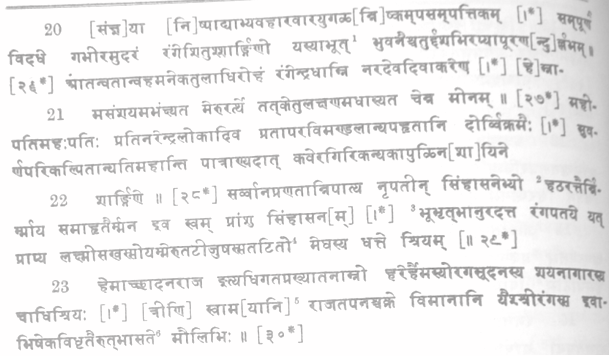|
The Indian Analyst
|
North Indian Inscriptions |
RANGANATHA INSCRIPTION OF SUNDARA-PANDYA.
TRANSLATION. Hari. Ãm. Hail ! Prosperity ! ......(Verse 1.) Having caused to long for the other world (i.e. to set or die) that Moon of the Karṇâta (country), by whom this lotus-pond7 of Śrîraṅga had been reduced to a pitiable state, (and) re-instating in this (lotus-pond of Śrîraṅga) (the goddess) Lakshmî, who is worshipped in the three worlds,— king Sundara-Pâṇḍya rose full of brilliancy,8 (like) the Sun. ......(V. 2.) The king who was the Mahêndra of the glorious (city of) Madhurâ, built for the lord of Raṅga a shrine (âlaya) with the gold which (he) had given by frequently performing the ascending of the scales.9 The mass of its rays, red like fresh roses, appears to be the dawn which indicates perpetually the rise of the bright moon of (the king’s) fame from the mountain of his (the god’s) raised arms.10
......(V. 3.) Having covered with gold the shrine (vimâna) of Hari (Vishṇu) at Raṅga, the Sun among kings placed in it (an image of) the highest being (parama-puṁs),— which consisted of gold to the tips of the nails, (and which he called) after that name of his, which had arisen out of that great work,11— just as the Yôgin (places the highest being) in (his) pure mind. ......(V. 4.) The Sun among kings gave to Śârṅgin (Vishṇu), who resides at Raṅga, a garland
of emeralds,12 which (he) had taken from the treasure of the Kâṭhaka king, (and) which, clinging
| ||||||||||||||||||||||||||||||||||||||||||||||||||||||||||||||||||||||||||||
| > |
|
>
|








